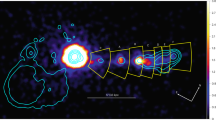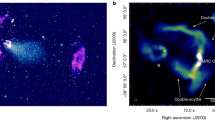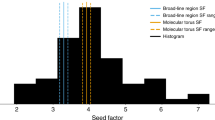Abstract
New observations at 1.6–3.45 µm confirm the presence of a dramatic (Δα ∼ 1) break between radio–IR wavelengths and 6,000 Å, in the spectrum of the M87 jet. These data, in combination with data taken in other spectral regions, show that the individual knots in the M87 jet have nearly the same spectral indices and nearly the same large (Δα ∼ 1) spectral break. This large spectral break and the constancy of spectral properties between the knots pose serious constraints for models of the M87 jet.
This is a preview of subscription content, access via your institution
Access options
Subscribe to this journal
Receive 51 print issues and online access
$199.00 per year
only $3.90 per issue
Buy this article
- Purchase on Springer Link
- Instant access to full article PDF
Prices may be subject to local taxes which are calculated during checkout
Similar content being viewed by others
References
Felten, J. E. Astrophys. J. 151, 861–879 (1968).
Miley, G. K. Rev. Astr. Astrophys. 18, 165–218 (1980).
Low, F. J. & Rieke, G. H. Methods of Experimental Physics Vol. 12, Pt A, (ed. Carlton, N.) 415–462 (Academic, New York, 1974).
Owen, F. N., Hardee, P. E. & Bignell, R. C. Astrophys. J. Lett. 239, L11–L15 (1980).
Laing, R. A. Mon. Not. R. astr. Soc. 193, 427–437 (1980).
Kinman, T. D., Grasdalen, G. L. & Rieke, G. H. Astrophys. J. Lett. 194, L1–L4 (1974).
Kaneko, N., Nishimura, M. & Toyama, K. Publ. astr. Soc. Jap 25, 175–180 (1973).
de Vaucouleurs, G. & Nieto, J.-L. Astrophys. J. 231, 364–371 (1979).
Ables, H. D. & Kron, G. E. Astrophys. J. 181, 19–25 (1973).
Sulentic, J. W., Arp, H. C. & Lorre, J. Astrophys. J. 233, 44–55 (1979).
Perola, C. & Tarenghi, M. Astr. Astrophys. (in the press).
Schreier, E. J., Feigelson, E. D. & Gorenstein, P. X. (in preparation, 1981).
de Vaucouleurs, G., Angione, R. & Fraser, C. W. Astrophys. Lett. 2, 141–146 (1968).
Mould, J., Aaronson, M. & Huchra, J. Astrophys. J. 238, 458–470 (1970).
Turland, B. D. Mon. Not. astr. Soc. 170, 281–294 (1975).
Kardashev, N. S. Soviet Astr. -AJ 6, 317–327 (1962).
Rieke, G. H. & Weekes, T. C. Astrophys. J. 155, 429–437 (1969).
Pesses, M. thesis, Univ. Iowa (1979).
Gould, R. J. & Burbidge, G. R. in Hdbuch Phys 46/2, 265–309 (1967).
Ginzberg, V. L. & Syrovetskij, S. I. The Origin of Cosmic Rays (transl. Massey, H. S. H.) (Pergamon, Oxford 1964).
Weekes, T. C., Fazio, G. G., Helmken, H. F., O'Mongain, E. & Rieke, G. H. Astrophys. J. 174, 165–179 (1972).
Author information
Authors and Affiliations
Rights and permissions
About this article
Cite this article
Stocke, J., Rieke, G. & Lebofsky, M. New observational constraints on the M87 jet. Nature 294, 319–322 (1981). https://doi.org/10.1038/294319a0
Received:
Accepted:
Issue Date:
DOI: https://doi.org/10.1038/294319a0
This article is cited by
-
Radio to optical spectral index variations along the M87 jet
Astrophysics and Space Science (1989)
Comments
By submitting a comment you agree to abide by our Terms and Community Guidelines. If you find something abusive or that does not comply with our terms or guidelines please flag it as inappropriate.



